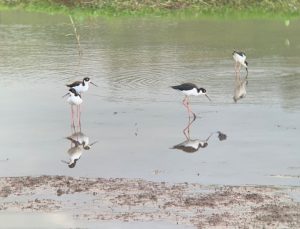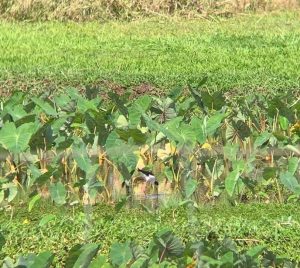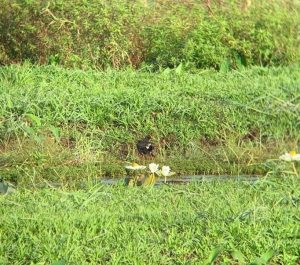
by Eryn Opie
Eryn is a Heʻeia NERR Graduate Assistant studying Natural Resources & Environmental Management at the University of Hawai‘i, Mānoa. Her research focuses on the “birdscape” in Heʻeia. Eryn is from Kailua, Oʻahu.
Heʻeia is a place where people, water, birds and plants are connected. Someone once said that “kalo is like people,” and this resonated with me because I feel the same way about birds. Some birds, like aeʻo, are alarmists and will squawk at you with a series of sharp “kik kik kik kik” if you get too close, the same way your grandma chased you when you ran through her house wearing slippers. Kōlea are kings of their castles. ‘Akekeke pace the shoreline in search of food by flipping limu and rocks, like how you might search the house for your missing keys. I’m not as familiar with kalo varieties, but I’ve learned that some grow and mature fast, while others take their time to open up when they are ready. Every living organism has a role in creating the dynamic interactions among the living and nonliving components that make up a healthy functioning community.

Hawaiian waterbird populations have declined to endangered status due to the loss of naturally occuring wetlands, loss of widespread flooded-field agriculture (loʻi), urbanization, and the introduction of mammalian predators and other invasive species. My research focuses on the coexistence of endangered Hawaiian waterbirds and loʻi kalo agroecosystems when managed with Indigenous practices. Loʻi serve as water retention and sediment collection basins that create heterogeneous landscapes, which are perfect habitat for Hawaiian waterbirds. Worldwide, waterbirds are known to inhabit flooded-field agricultural systems such as rice fields which is well-documented and studied. Despite it being commonly known locally that waterbirds inhabit loʻi across Hawaiʻi, this phenomenon is not well documented or studied within the scientific community. The ongoing restoration of loʻi kalo in Heʻeia thus provides an opportunity to understand the relationship between loʻi kalo management, waterbird habitat use, and the potential of loʻi and Hawaiian waterbird conservation efforts to mutually benefit each other.

A variety of waterbird species with differing habitat requirements are able to utilize the landscape because each kalo patch within the network of patches is at a different stage in its growth cycle, providing a mosaic of unique habitats. There are five endemic Hawaiian waterbird species that inhabit loʻi: aeʻo (Hawaiian stilt), ʻalae ʻula (Hawaiian gallinule), ʻalae keʻokeʻo (Hawaiian coot), koloa maoli (Hawaiian duck) and nēnē (Hawaiian goose). Migratory shorebird species are also found here, the most common including: kōlea (Pacific golden plover),ʻūlili (Wandering tattler), ʻakekeke (Ruddy turnstone), and hunakai (Sanderling). Since loʻi restoration efforts began in Heʻeia about ten years ago, aeʻo, ʻalae ʻula and kōlea have started showing up regularly to utilize the loʻi, with successful nestings by the aeʻo and ʻalae ʻula.
The concept of “synanthropic” species, refers to wildlife that live near and benefit from habitats created by humans. Some examples of avian synanthropic species in Hawaiʻi are red-vented bulbuls, pigeons, and mynas that utilize urban spaces such as roads, powerlines, grassy parks and your yard. However, this phenomenon is not commonly observed in endangered species. My experience conducting research in Heʻeia has taught me that endangered Hawaiian waterbirds benefit from the habitats that are created by kalo farming. Some waterbirds are familiar with the people who are present in the loʻi everyday. I see this in the way ‘alae ‘ula will forage in the loʻi near the farmers removing weeds, or aeʻo that will remain calm when farmers are carrying out their work in the same space the aeʻo view as their territory. As aeʻo chics get older, some people have experienced the parents letting their offspring forage close to where the farmers are working. In contrast, aeʻo attack and chase away others who they view as threats when they have young chics nearby, such as egrets, myna birds, their native predators ʻaukuʻu, and even me at times as I conduct my bird observations. This makes sense, as the birds learn over time that the people who are there every day tending kalo patches and ʻauwai are not a threat. Their actions, such as pulling weeds, fertilizing, hehi (stomping crop residue), tilling, adjusting water levels, etc., are actually benefiting the birds. They’re bringing food sources to the surface and maintaining vegetation, providing right amount of shelter and open water for the birds to thrive. The routine maintenance of vegetation also keeps an open view plane for the birds to be aware of what’s going on around them, aeʻo particularly like this.

These actions are managing life cycles within the “mini” ecosystems (loʻi) on the same time and spatial scales that make the coexistence of waterbirds and agriculture possible.
Loʻi kalo are rich ecosystems that provide much more than kalo for sustenance. In addition to waterbirds, native fish, plants, and invertebrates boost the biodiversity of these systems. Diversity is the key to a healthy ecosystem. The ebb and flow of one life form allows for others to grow, and other life cycles to take place, within and around each other. What I’ve observed so far, in integrating the life cycles of kalo and waterbirds, is that multiple, diverse life cycles co-occur across varying temporal and spatial scales. Natural or anthropogenic disturbances, such as floods or changes in vegetation, cause shifts in the availability of resources, resulting in a temporary change of the dominant life cycle. Harnessing this phenomenon in agriculture through rotation of crops, maintaining desired vegetation and allowing for patches to fallow and nutrients to cycle back into the soil, creates the agroecosystem that allows for an abundance of resources for both humans and waterbirds to thrive.

Waterbirds and Indigenous agriculture pose a great opportunity to use coexistence models for native species mangement in Hawaiʻi. Aside from endangered waterbird management, restoration of kalo farming serves to continue the deeply rooted cultural practice of agriculture. It moves Hawaiʻi towards sustainable food independence. By realizing the shift to coexistence in how we manage ecosystems today, we rediscover the inherent reciprocal relationship that we have with our environment. We take care of our space because it’s also how we take care of each other. Believing this through doing, we start to care for aeʻo the same way we care for our grandmas – in part by showing respect through always taking off our slippers.
